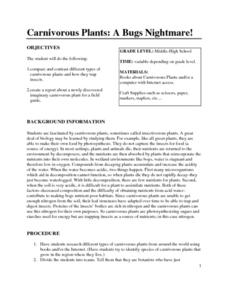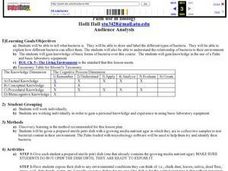Curated OER
Why Don't Whales Have Legs?
High schoolers are given a variety of materials and are asked to design a heat loss experiment that results in a reasonable explanation of "Why don't whales have legs?" students work with the theory of natural selection.
Curated OER
Carnivorous Plants: A Bugs Nightmare!
Students research carnivorous plants and how they trap insects. They role play as botanists to write a research field guide about a newly discovered imaginary carnivorous plant.
Curated OER
Lets Think About...Plants
Students bring in various vegetables and make friendship soup. They plant seeds and discuss the things plants need to grow and thrive.
Curated OER
The Letter Dd
Students explore the concept of the letter Dd. In this letter recognition lesson plan, students are engulfed with items, movement, and music that begin with the letter Dd. Students create crafts that help them learn and...
Curated OER
Sea Surface Temperature Trends of the Gulf Stream
Students use authentic satellite data to produce plots and graphs of sea surface temperature as they explore the seasonal changes of the Gulf Stream.
Curated OER
Trees
Fourth graders discuss the function of roots, trunk, crown, bark, cambium heartwood, and leaves of a tree. They create a tree diagram and label roots, trunk, crown, bark, cambium heartwood and leaves when shown a list of parts and an...
Curated OER
Sea Surface Temperature Trends of the Gulf Stream
Students explore the importance of the Gulf Stream. Using a NASA satellite images, they examine the sea surface temperature. Students collect the temperature at various locations and times. Using spreadsheet technology, they graph the...
Curated OER
Great River Bend Adventure
Students use their imagination. They discuss the 4 C's of teamwork: Concentration, Communications, Coomperation, and Consideration. Students discuss the safety guidelines of the project. They complete a rope maze. The group walks...
Curated OER
Swim Like a Whale or Fish?
Students recognize the difference between whales and fish by categorizing them according to their method of swimming. They synthesize this information by simulating the swimming patterns of whales and fish and comparing it to their own.
Curated OER
Frogz
Students perform jumps and leaps from one lily pad to another to add to a study of frogs.
Curated OER
The Tank
Students have a better grasp of the ecosystem of the St. Mary's river. They analyze how the tank is meant to be a miniature of the river. Students inquire how to take care of the tank and its inhabitants. They are introduced to Fundulus...
Curated OER
Emerging Viruses
Students study the characteristics of living things and explore the characteristics of viruses including their structure, function, and reproductive cycles. They also explore the impact of viruses on human health by discussing common...
Curated OER
The Learning Bottleneck
Students identify and analyze what energy is and how they feel after moving around a lot. They identify other ways that they can acquire heat and if there is some sort of mechanism for storing energy. Finally, students construct their...
Curated OER
All About Ducks for Kids
In this duck facts worksheet, students read series of paragraphs from on online website about ducks. Students may then complete several related duck activities.
Curated OER
House on Mango Street
Young scholars complete readingactiviteis for Sandra Cisneros' House on Mango Street. In this House on Mango Street lesson, students complete pre-reading and close reading activities for vignettes from the text. Young scholars...
Curated OER
Poriferans and Cnidarians
Students study the major phyla of the animal kingdom. In this biology lesson unit, students identify their general characteristics. They define taxonomy terminologies.
Curated OER
Barnacles: Harder than Cement
Fourth graders watch the movements of the complex animal hidden inside the tiny barnacle shells. This lesson allows students to study the behavior, adaptation, and larval stage of the barnacle.
Curated OER
Palm Use in Biology
Young scholars view bacteria through a microscope. They draw and label the bacteria using microbiology software loaded onto their Palms.
Curated OER
The Big Crush
Learners examine weather maps from their state from the past few days. They examine the Highs and Lows on the maps to determine what kind of weather they produce. They use that information to better prepare for their activities and what...
Curated OER
Solving Saturn's Mysteries
Students study the Cassini spacecraft and its travel to Saturn. They discover the results of the space mission and examine images of Saturn that Cassini sent back.
Curated OER
The Ebb-Tide
Pupils study "The Ebb-Tide", an original drama based on the novel by Robert Louis Stevenson."The Ebb-Tide", like many of Stevenson's works, is a nautical adventure combining mystery, murder and memorable char
Curated OER
Liquid Crystal IR Detector
Students experiment with one method of detecting infrared radiation. They simulate the detection of infrared radiation using a liquid crystal sheet.
Curated OER
Bird Beak Anatomy
Third graders participate in an activity to determine which tool will work the best to gather food. They create analogies about how the experiment relates to birds. They brainstorm about which adaptation helps or hurts the survival of an...
Curated OER
Somewhere in the World . . . .
Students, in groups, choose a country. On the surface of an inflated balloon, they draw/write information (geographic and otherwise) about the country. To finish the project, they make a basket for the balloon and then give a 2-3...

























